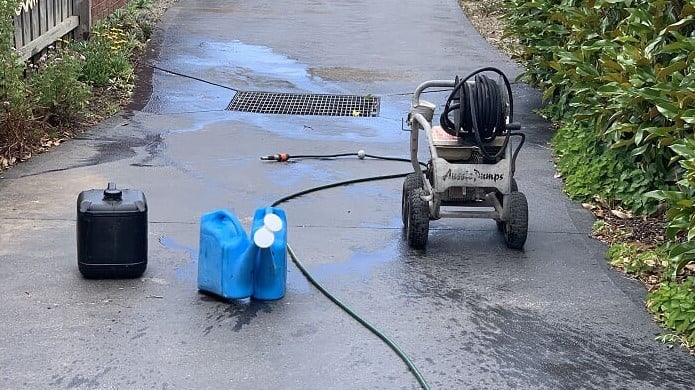
As with most concrete sealers, surface preparation is crucial to ensuring good adhesion. Stains and marks can impact on the effectiveness and appearance of the sealer, so it’s important to deal with them before doing anything else. But cleaning off stubborn stains can be a real chore, especially if you’re intending to apply a clear coating.
Here are our top tips on how to remove those stubborn stains.
Important note: these tips are recommended for uncoated / unsealed concrete.
First things first – apply an acid wash
A light acid wash will clean the surface dust and dirt and will also open the pores of the concrete, enabling the sealer to penetrate the surface.
Simply add 1 part acid to 20 parts water and apply liberally to the surface with a watering can. Let it dwell on the surface for up to 30mins before washing down, ideally with a high-pressure water blaster.
Removing moss and algae
If your concrete has any organic matter growing on the surface, this must be treated before applying a sealer. Whilst a good wash with a water blaster will generally remove the moss, it will regrow quickly, even under a coating.
Apply chlorine to the surface with a watering can and ideally scrub into the surface. Allow to dwell on the surface for 30mins before washing off with a hose or high-pressure cleaner.
Removing timber (tannin) stains
If you’ve ever built a timber deck for your home, the timber was likely dropped off on your concrete driveway. After you finished building your deck, you may have discovered stain marks on the driveway. This would have been caused by the naturally occurring tannins in the timber leeching out of the timber and onto your driveway.
Deck cleaner contains chemicals specifically designed to break down timber tannins. Simply scrub a suitable deck cleaning chemical onto the surface of your driveway. Allow to dwell on the surface for 30mins before washing off with a high-pressure washer.
Removing oil and grease stains
To remove localised oil and grease stains, you will need to mix up a poultice. A poultice is generally a mix of a dry powder with a chemical to create a paste. The paste holds the chemical to the surface, preventing it from drying out and ensuring the chemical stays in contact with the stain.
Mix talcum powder and acetone into a paste and apply at approximately 5mm thick to the affected area ensuring you cover the area at least 50-100mm past the edge of the stain.
Cover the poultice with plastic and leave for 24 hours before cleaning off. The poultice should draw the stain out of the concrete into the poultice.
Removing rust stains
With rust stains, it is important to identify the source of rust. If the rusting is coming from within the slab, this needs to be treated separately.
For surface rust stains, proprietary rust removers such as Adbrite LA827, contain oxalic or phosphoric acids which are both great for removing surface rust. Such rust removers are typically brushed on the affected area then thoroughly washed off with a hose or high-pressure washer.
Removing efflorescence
Efflorescence is the formation of salts on the surface of concrete, deposited by ground water rising through the concrete. They can easily be removed using household vinegar or a very weak acid mix. This will remove the salts from the surface; however they may reappear if the underlying ground pressure is not resolved.
Rubber tyre marks
Tyre marks can normally be removed by washing with a high-pressure washer. If the stain persists, apply brake cleaner to the stain then wash thoroughly with water. This may need to be applied numerous times to break down the rubber compound.
Need more expert advice on concrete stain removal? Talk to the team at Allcon
We’re a family business with over 100 year’s collective experience in specialist concrete construction products, so we know the hard truths about concrete. Call us on 1300 255 266. Or click here to get in touch.
